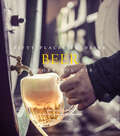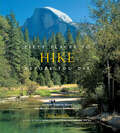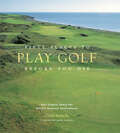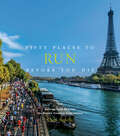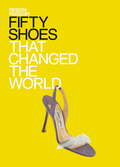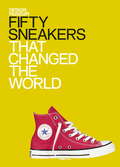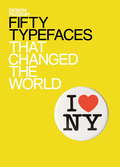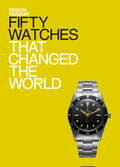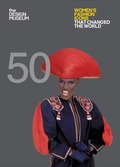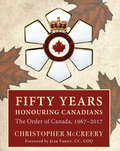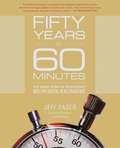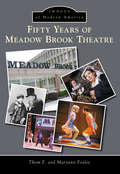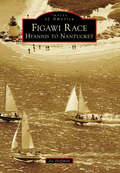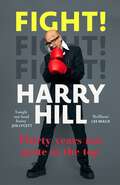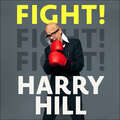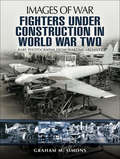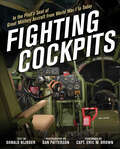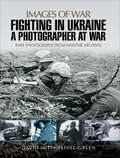- Table View
- List View
Fifty Places to Drink Beer Before You Die: Beer Experts Share the World's Greatest Destinations (Fifty Places Ser.)
by Chris SantellaA beautiful guide to the world’s fifty best places to enjoy a beer, from Alabama to Zimbabwe, as chosen by experts connected to the industry.What is the most unforgettable place you’ve ever taken a refreshing sip of a cold beer? In Fifty Places to Drink Beer Before You Die, Chris Santella explores the best destinations to crack open a cold one, reflect on the day, and take in the scenery. The book features the world’s top locations for imbibing, from beautiful landscapes to beer festivals, breweries, classic drinking establishments, and brand-new, under-the-radar spots. With a mix of national and international places to visit—Asheville, Denver, Prague, Munich, Vienna, and more—as well as firsthand accounts from contributors such as Jim Koch (founder of Boston Brewing Company/ Samuel Adams) and Joe Wiebe (author of Craft Beer Revolution), this book will make you want to trek to each must-see destination. Packed with beautiful, vibrant photographs that bring each locale to life, Fifty Places to Drink Beer Before You Die will leave you craving barley and hops and eagerly planning your next trip.
Fifty Places to Hike Before You Die: Outdoor Experts Share the World's Greatest Destinations (Fifty Places Ser.)
by Chris SantellaA breathtaking guide to fifty of the world’s greatest locations to hike, as selected by the experts who have been there.Fifty Places to Hike Before You Die is the latest offering in the bestselling Fifty Places series. Chris Santella, along with top expedition leaders, explores the world’s greatest walking adventures. Some, such as the Lunana Snowman Trek in Bhutan and the Kangshung Valley Trek in Tibet, are grueling multiweek adventures at high altitudes. Others, such as Japan’s Nakesando Trail, move leisurely from village to village, allowing walkers to immerse themselves in the local culture. Whether it’s climbing the Rwandan mountains to view mountain gorillas or strolling through bistros along Italy’s Amalfi Coast, there’s a memorable hike at everyone’s level within these 50 chapters. With commentaries from expert trekkers and insider tips that lead the reader off the beaten path, Santella has again captured the special characteristics that make these must-visit destinations.
Fifty Places to Play Golf Before You Die: Golf Experts Share the World's Greatest Destinations (Fifty Places)
by Chris SantellaA stunning, in-depth guide to fifty of the world’s greatest golf courses, selected by people deeply connected to the sport.There’s an incredible similarity between the mechanics of a fly cast and the swing of a golf club. Perhaps that's why Chris Santella, author of Fifty Places to Fly Fish Before You Die, can be found on the links when he’s not on the stream. With Fifty Places to Play Golf Before You Die, Santella gives voice to his other sporting passion, interviewing 50 people intimately connected to the sport about some of their favorite courses around the world.For both passionate golfers and armchair travelers, this gorgeous full-color book presents the world’s greatest golf venues, the personal favorites of renowned players, course architects, and other experts in the sport. From Ballyliffin, Ireland’s northernmost course, whose rumpled fairways wander along the North Sea in the shadows of Glashedy Rock, to New Zealand's Cape Kidnappers, perched atop dramatic cliffs some 500 feet above the ocean, the book’s beautiful photographs capture the architecture, noteworthy holes, location, and ambiance that make these courses standouts for ardent golfers. A brief history of each course, an experiential account-filled with local color-from the person recommending the venue, and trip-planning advice provide adventurous readers with all the information they need to chip and putt their way around the globe.A close-up look at golf’s top courses around the world, recommended by such experts as Nick Faldo and Christie Kerr (pro golfers), Pete Dye and Tom Doak (course architects), and Brian McCallen (editor and author).With breathtaking color photographs of each site, this is a great gift for avid golfers and armchair travelers alike.
Fifty Places to Run Before You Die: Running Experts Share the World's Greatest Destinations (Fifty Places)
by Chris SantellaA breathtaking guide to the world’s fifty best places to run, as chosen by experts who’ve been there.The beautiful thing about running is that all you need is a trusty pair of shoes and a little determination. When you can practice a sport almost anywhere, from your own neighborhood to courses across the world, where do you begin? In Fifty Places to Run Before You Die, Chris Santella gathers fifty bucket list recommendations from some of the running world’s most accomplished leaders and athletes, including ultra-runner and record breaker Jim Walmsley; Runner’s World chief running officer Bart Yasso; NPR star Peter Sagal; race director of the Boston Marathon Dave McGillivray; U.S. Olympian Magdalena Lewy Boulet; and internationally recognized endurance athlete Dean Karnazes.Featuring a mix of popular foot races (such as marathons, 10Ks, and endurance runs) and scenic trails off the beaten path, this book divulges what makes each venue unique, offering firsthand anecdotes and practical advice for those who aspire to run there. Discover incredible events and trails both national and international, including the Ultra-Trail du Mont-Blanc in France, the New York City Marathon, the Vancouver Sun Run, the Grand Canyon, the Dolomites in Italy, and the Great Ocean Road Marathon in Australia. Fifty Places to Run Before You Die is the essential travel companion for runners of all levels who seek to conquer new terrain while breaking personal records.
Fifty Shoes That Changed the World: Design Museum Fifty (Design Museum Fifty Ser.)
by Design Museum Enterprise LimitedEverything around us is designed and the word 'design' has become part of our everyday experience. But how much do we know about it? Fifty Shoes That Changed the World imparts that knowledge listing the top 50 shoe designs that have made a substantial impact in the world of design today. From the 1863 Frye boot to Zaha Hadid's 2008 Melissa shoe, each entry offers a short appraisal to explore what has made their iconic status and the designers that give them a special place in design history.
Fifty Shoes that Changed the World: Design Museum Fifty (Design Museum Fifty)
by Design Museum Enterprise LimitedEverything around us is designed and the word 'design' has become part of our everyday experience. But how much do we know about it? Fifty Shoes That Changed the World imparts that knowledge listing the top 50 shoe designs that have made a substantial impact in the world of design today. From the 1863 Frye boot to Zaha Hadid's 2008 Melissa shoe, each entry offers a short appraisal to explore what has made their iconic status and the designers that give them a special place in design history.
Fifty Sneakers That Changed the World: Design Museum Fifty (Design Museum Fifty)
by Design Museum Enterprise Limited Alex NewsonOver the course of its history the sneaker has undergone a complete transformation, taking it from functional sportswear to high fashion. The Design Museum's Alex Newson traces this evolution through the 50 most influential examples, from the classic Converse All Star up to the very latest blends of technological innovation and fashion-conscious style.
Fifty Typefaces That Changed the World: Design Museum Fifty (Design Museum Fifty Ser.)
by John L WaltersThe Design Museum brings you fifty typefaces that changed the world we live in!The digital revolution has made typesetters of us all as we define our identities through the typefaces we choose to communicate with the world. In this witty and insightful book John L Waters explores 50 of the most influential typefaces and shows them in use on posters, perfume packaging, buildings and more. From the power of Gotham - the typeface used in Obama's first presidential campaign - to the eloquence of Baskerville, from the classic cool of Helvetica to Wim Crouwel's provocative New Alphabet, this is a book of visual treats and wonderful stories.Contents Includes...Blackletter c.1455First Roman Type c.1470Garamond c.1532Romain du Roi 1690 - 1745Baskerville 1757Bodoni late 1780sThe first Egyptians (slab serifs) 1810Wood Types - condensed grotesques 1828 - c.1900The First Typewriter 1868Franklin Gothic Condensed 1903 - 14Cooper Black 1921Futura 1927Times new Roman (aka Times Roman) 1932Helvetica 1957Beowolf 1989Comic sans 1994Gotham 2000Guardian Egyptian 2005-Ubuntu 2011...And Many More!
Fifty Typefaces That Changed the World: Design Museum Fifty (Design Museum Fifty)
by John L WaltersThe Design Museum brings you fifty typefaces that changed the world we live in!The digital revolution has made typesetters of us all as we define our identities through the typefaces we choose to communicate with the world. In this witty and insightful book John L Waters explores 50 of the most influential typefaces and shows them in use on posters, perfume packaging, buildings and more. From the power of Gotham - the typeface used in Obama's first presidential campaign - to the eloquence of Baskerville, from the classic cool of Helvetica to Wim Crouwel's provocative New Alphabet, this is a book of visual treats and wonderful stories.Contents Includes...Blackletter c.1455First Roman Type c.1470Garamond c.1532Romain du Roi 1690 - 1745Baskerville 1757Bodoni late 1780sThe first Egyptians (slab serifs) 1810Wood Types - condensed grotesques 1828 - c.1900The First Typewriter 1868Franklin Gothic Condensed 1903 - 14Cooper Black 1921Futura 1927Times new Roman (aka Times Roman) 1932Helvetica 1957Beowolf 1989Comic sans 1994Gotham 2000Guardian Egyptian 2005-Ubuntu 2011...And Many More!
Fifty Watches That Changed the World: Design Museum Fifty (Design Museum Fifty)
by Design Museum Enterprise Limited Alex NewsonThe watch has long been a favourite of the design world - both as an indication of the wearer's style and as a test of the designer's ethos and aesthetic. From the early efforts of Le Corbusier and Louis-Francois Cartier to the advent of the digital era and the arrival of the smartwatch, the Design Museum examines the 50 most important and eye-catching examples of all time.
Fifty Women's Fashion Icons that Changed the World: Design Museum Fifty (Design Museum Fifty)
by Design Museum Enterprise Limited Lauren CochraneFashion is a powerful thing. It can be used for self-expression, to make a political statement, or simply to attract attention. Through this stunning collection, discover how these 50 trendsetters - from Twiggy to Wallis Simpson, Tilda Swinton to Michelle Obama - have used fashion to assert their position in the world and become iconic. With stunning photography selected by the Design Museum, in conjunction with Lauren Cochrane, Assistant Fashion Editor at the Guardian, Fifty Women's Fashion Icons is the perfect gift for design lovers and fashion followers of all ages.
Fifty Years Honouring Canadians: The Order of Canada, 1967–2017
by Christopher MccreeryThis fully illustrated history traces the Order of Canada from its establishment in 1967 to its place today as a national honour. Over the past fifty years more than six thousand Canadians have been appointed to the Order of Canada. Those who embody the motto of the Order through their efforts to “Desire a better country,” continue to be recognized by the Crown and their fellow Canadians with the familiar white snowflake insignia. This illustrated history traces the origins of the Order, from the debate surrounding Canadians accepting peerages and knighthoods that took place during the First World War, through to Vincent Massey and Lester Pearson’s great desire to see their fellow citizens recognized with a truly Canadian honour. Details about the design of the insignia, investitures, and prominent members of the Order of Canada are also included. Rich with illustrations and historical vignettes, this book provides an easily accessible window into the fascinating history of our pre-eminent national honour.
Fifty Years of "The Battle of Algiers": Past as Prologue (Forerunners: Ideas First)
by Sohail DaulatzaiThe Battle of Algiers, a 1966 film that poetically captures Algerian resistance to French colonial occupation, is widely considered one of the greatest political films of all time. With an artistic defiance that matched the boldness of the anticolonial struggles of the time, it was embraced across the political spectrum—from leftist groups like the Black Panther Party and the Palestine Liberation Organization to right-wing juntas in the 1970s and later, the Pentagon in 2003. With a philosophical nod to Frantz Fanon, Sohail Daulatzai demonstrates that tracing the film&’s afterlife reveals a larger story about how dreams of freedom were shared and crushed in the fifty years since its release. As the War on Terror expands and the &“threat&” of the Muslim looms, The Battle of Algiers is more than an artifact of the past—it&’s a prophetic testament to the present and a cautionary tale of an imperial future, as perpetual war has been declared on permanent unrest.Forerunners: Ideas First is a thought-in-process series of breakthrough digital publications. Written between fresh ideas and finished books, Forerunners draws on scholarly work initiated in notable blogs, social media, conference plenaries, journal articles, and the synergy of academic exchange. This is gray literature publishing: where intense thinking, change, and speculation take place in scholarship.
Fifty Years of 60 Minutes: The Inside Story of Television's Most Influential News Broadcast
by Jeff FagerThe ultimate inside story of 60 Minutes, the program that has tracked and shaped the biggest moments in post-war American history.From its almost accidental birth in 1968, 60 Minutes has set the standard for broadcast journalism, joining us in our living rooms each Sunday night to surprise us about the world. The show has profiled every major leader, artist, and movement of the past five decades, perfecting the news-making interview and inventing the groundbreaking TV expose. From legendary sit-downs with Richard Nixon in 1968 (in which he promised “to restore respect to the presidency”) and Bill Clinton in 1992 (after the first revelations of infidelity) to landmark investigations into the tobacco industry, Lance Armstrong’s doping, and the torture of prisoners in Abu-Ghraib, the broadcast has not just reported on our world but changed it too. Now, Executive Producer Jeff Fager pulls back the curtain on how this remarkable journalism is done, taking the reader into the editing room with the show’s brilliant producers and beloved correspondents, including hard-charging Mike Wallace, writer’s-writer Morley Safer, soft-but-tough Ed Bradley, relentless Lesley Stahl, ace interviewer Charlie Rose, tireless Anderson Cooper, intrepid Scott Pelley, and illuminating storyteller Steve Kroft. He details the decades of human drama that have made the show’s success possible: the ferocious (and encouraged) competition between correspondents, the door slamming, the risk-taking, and the pranks. Fager takes on the program’s mistakes and describes what it learned from them. Above all, he reveals the essential tenets that have never changed: why founder Don Hewitt believed “hearing” a story is more important than seeing it, why the “small picture” is the best way to illuminate a larger one, and why the most memorable stories are almost always those with a human being at the center. At once a sweeping portrait of fifty years of American cultural history and an intimate look at how the news gets made, Fifty Years of 60 Minutes shares the secret of what’s made the nation’s favorite TV program exceptional for all these years.
Fifty Years of Meadow Brook Theatre
by Thom F. Foxlee Maryann FoxleeMeadow Brook Theatre (MBT) began in 1966 as part of a strategy to associate professional music and theatre with Oakland University's academic programs. The theater became a reality when John Fernald, an internationally acclaimed director and head of London's Royal Academy of Dramatic Art, accepted Chancellor D.B. Varner's invitation to establish a resident professional theatre company on the university's campus. In January 1967, the curtain rose; nearly five decades later, MBT remains a key element of Oakland County's cultural fabric. Many famous actors--including William Hurt, Curtis Armstrong, and Cindy Williams--have appeared on its stage.
Figawi Race: Hyannis to Nantucket
by Joe HoffmanWhen three friends gathered at Baxter's Boathouse in 1972 to discuss their Memorial Day weekend plans over a few beers, none of them would have suspected that they were on the verge of creating one of the prestigious sailing events on the Atlantic coast. The Figawi Race began as a challenge among a group of sailing enthusiasts who wanted to see who could race their boat to Nantucket first. After the first race, in which Bob "Red" Luby beat out brothers Bob and Joe Horan, it was decided by Bob Horan that it should become an annual event. In 1973, there were 15 boats, and the Figawi Race was off and running. The race evolved into a three-day event complete with a New England clambake. Figawi Race: Hyannis to Nantucket shares photographs and stories of a race that for over 40 years has continued to bring friends and sailors together.
Fight!: Thirty Years Not Quite at the Top
by Harry Hill'The funniest man in the world has written the funniest book in the world.' DAVID WALLIAMS'A brilliant insight in to what it takes to go from regular funny bloke to one of the best stand ups I've ever seen.' LEE MACK'Proper laugh-out-loud funny, fascinating, and doubles up as probably the best book of advice on how to be a comedian I've ever read. A must for anyone who's interested in the business of laughter.' JOE LYCETTFrom a childhood spent making smoke bombs, killing wasps and carving soap in 70s Kent, Harry Hill then found himself in charge of hundreds of sick people as a junior doctor. Out of his depth and terrified, he chucked it all in to pursue his dream of becoming a stand-up comedian. Battling his way through the 90s Comedy circuit he quickly rose to become a household name and one of the UK's most celebrated comics, almost making it to the top of the showbiz tree . . .From being chased around a car park by an angry heckler, getting fired from Capital Radio and watching every episode of Freaky Eaters, to a bizarre assassination attempt and cutting up Simon Cowell's trousers, Harry takes an honest and hilarious look at the ups and downs of his life and career through the lens of what didn't go right.He shares his secrets on how to be a great comedian, finding joy in failure and creativity in struggle, whilst never forgetting that life is short . . .
Fight!: Thirty Years Not Quite at the Top
by Harry Hill'The funniest man in the world has written the funniest book in the world.' DAVID WALLIAMS'A brilliant insight in to what it takes to go from regular funny bloke to one of the best stand ups I've ever seen.' LEE MACK'Proper laugh-out-loud funny, fascinating, and doubles up as probably the best book of advice on how to be a comedian. A must for anyone who's interested in the business of laughter.' JOE LYCETTFrom a childhood spent making smoke bombs, killing wasps and carving soap in 70s Kent, Harry Hill then found himself in charge of hundreds of sick people as a junior doctor. Out of his depth and terrified, he chucked it all in to pursue his dream of becoming a stand-up comedian. Battling his way through the 90s Comedy circuit he quickly rose to become a household name and one of the UK's most celebrated comics, almost making it to the top of the showbiz tree . . .From being chased around a car park by an angry heckler, getting fired from Capital Radio and watching every episode of Freaky Eaters, to a bizarre assassination attempt and cutting up Simon Cowell's trousers, Harry takes an honest and hilarious look at the ups and downs of his life and career through the lens of what didn't go right.He shares his secrets on how to be a great comedian, finding joy in failure and creativity in struggle, whilst never forgetting that life is short . . .What readers are saying about Fight!'Hilarious... recommended unreservedly' *****'Lots of laughs and memories of days gone by' *****'A great book... I could not put it down' *****'Beautifully written and great fun' *****(P) 2021 Hodder & Stoughton Limited
Fight!: Thirty Years Not Quite at the Top
by Harry HillA TIMES BEST COMEDY BOOK OF 2021'The funniest man in the world has written the funniest book in the world' DAVID WALLIAMS'A brilliant insight into what it takes to go from regular funny bloke to one of the best stand-ups I've ever seen' LEE MACK'Proper laugh-out-loud funny, fascinating, and...a must for anyone who's interested in the business of laughter' JOE LYCETTAfter a childhood spent making smoke bombs, killing wasps and carving soap in 70s Kent, Harry Hill then found himself in charge of hundreds of sick people as a junior doctor. Out of his depth and terrified, he chucked it all in to pursue his dream of becoming a stand-up comedian. Battling his way through the 90s comedy circuit he quickly rose to become a household name and one of the UK's most celebrated comics, almost making it to the top of the showbiz tree...From being chased by an angry heckler and getting fired from Capital Radio to a bizarre assassination attempt and cutting up Simon Cowell's trousers, Harry takes an honest and hilarious look at the ups and downs of his life and career, finding joy in failure and creativity in struggle, whilst never forgetting that life is short.
Fighters Under Construction in World War Two: Rare Photographs From Wartime Archives (Images of War)
by Graham M. SimonsThere has been bookshelf after bookshelf of books compiled, written and published about British aircraft, the Royal Air Force and the activities of its pilots during World War Two. Tales of derring do, bravery and gallantry quite rightly litter the bookshelves and libraries, but little has appeared in print about the could be called the unsung heroes, those that designed, built and maintained the fighting equipment used to eventually defeat the enemy.This is all the more incredible when one realizes that there exists a huge archive of images that have survived which clearly show the skills and scale of what went on. These images of war—many of which are seen here for almost the first time in seventy years—form a remarkable tribute to the designers, engineers and workers who did so much.Following the end of the Great War, the Royal Air Force was drastically reduced in both manpower and equipment. The application of a 'Ten Year Rule in which the British Government foresaw no war being fought during the next ten years resulted in minimal defense expenditure throughout the 1920s.Financial restrictions went on until the early 1930s, when it at last became apparent that Germany was developing expansionist and aggressive tendencies that could no longer be ignored. The British Government and Air Ministry at last began to develop plans of their own to expand and develop the Royal Air Force. The Cabinet approved a number of plans, but a revised one often replaced each one before the original could be completed.Between 1933 and 1939, the Royal Air Force was given higher priority in terms of rearmament plans than the other services. The policy was driven by the pursuit of parity with Germany more than by defense and strike needs, for there was no fixed ratio of bombers to fighter aircraft to guide procurement.There could be no expansion without manufacturing capacity and luckily these manufacturers were not only capable of producing, but they also recorded much of their activities and remarkably a huge archive of images have survived which clearly show the skills and scale of what went on. These images of war—many of which are seen here for almost the first time in seventy years—form a remarkable tribute to the designers, engineers and workers who did so much.
Fighting Cockpits: In the Pilot's Seat of Great Military Aircraft from World War I to Today
by Dan Patterson Donald NijboerWhat was it like to sit in the pilot's seat and take control of a P-51 Mustang in World War II? What about an F-14 Tomcat at the height of the Cold War? Or a Lockheed Martin F-22 Raptor today? The cockpits of these fighter and bomber aircraft are revealed in Fighting Cockpits. Showcasing more than 50 of the world's most famous combat cockpits from early World War I aircraft to present-day fighters, this book includes more than 200 rich color photos from photographer Dan Patterson, as well as detailed history about combat cockpit development from aviation expert and historian Donald Nijboer.Presented in large-format, you'll be blown away by studio shot spreads of views from the cockpits, vintage photographs of the aircrafts in action, and modern photography of surviving crafts. This book will complete any history buff or aviation enthusiast's library.Aircraft include:Wind in the Wires: Nieuport 28, Royal Aircraft Factory S.E.5, Bristol F.2, Fokker Dr.I, Sopwith Camel, Sopwith Triplane, AEG G.IV, SPAD VII, Halberstadt CL.IV, Fokker D.VIIThe Rise of the Monoplane: Martin MB-2, Hawker Hind, Fiat CR.32, Boeing P-26 Peashooter, Curtiss F9C, Sparrowhawk, Vought SB2U Vindicator, Westland Lysander, PZL P.11World War II: Supermarine Spitfire, Messerschmitt Bf 109, Republic P-47 Thunderbolt, North American P-51 Mustang, Handley Page Halifax, Vickers Wellington, Focke-Wulf Fw 190 Wurger, Fairey Firefly, Fiat CR.42, Ilyushin Il-2 Sturmovik, Heinkel He 219 Uhu, Kawasaki Ki-45 Toryu, Curtiss SB2C Helldiver, Northrop P-61 Black Widow, Boeing B-17 Flying Fortress, Boeing B-29 Superfortress, Dornier Do 335 Pfeil, Messerschmitt Me 262 Schwalbe, Arado Ar 234 BlitzCold War to the Present: North American F-86 Sabre, Boeing B-52 Stratofortress, Grumman A-6 Intruder, General Dynamics F-111 Aardvark, Hawker Siddeley Harrier, McDonnell Douglas/Boeing F-15 Eagle, Grumman F-14 Tomcat, Fairchild Republic A-10 Thunderbolt II, General Dynamics/Lockheed Martin F-16 Fighting Falcon, Mikoyan MiG-29, Rockwell B-1 Lancer, Lockheed Martin F-117 Nighthawk, Lockheed Martin F-22 Raptor, Lockheed Martin F-35 Lightning II Joint Strike Fighter
Fighting for Air: In the Trenches with Television News
by Liz TrottaLiz Trotta traces her career from the early days of broadcast news to the slick superficiality of today. The first female television correspondent in Vietnam, Trotta tells the searing truth about being a woman in a male-dominated industry and recounts many of her most fascinating stories, from the scandal of Chappaquiddick to the campaign trail of George Bush.
Fighting in Ukraine: A Photographer at War (Images of War)
by David Mitchelhill-GreenThis WWII pictorial history shares the personal images captured by a German photographer and soldier who fought on the Eastern Front. The outcome of the Second World War was decided on the Eastern Front. Denied a swift victory over Stalin&’s Red Army, Hitler&’s Wehrmacht found itself in a bloody, protracted struggle that it was ill-prepared to fight. Fighting in the Ukraine captures the drama and struggle of the Eastern Front through the extraordinary personal record of a professional photographer, Walter Grimm, who served in the German Army in a communications unit. David Mitchelhill-Green brings Grimm&’s previously unpublished photographs together with a highly informative introduction. The 300 evocative black and white images provide an absorbing insight into the daily life and privations of the ordinary German soldier amid the maelstrom of history&’s largest conflict. The Ukrainian people, many of whom initially welcomed the Germans as liberators, freeing them from Bolshevik oppression, are also chronicled in this fascinating photographic study.
Fighting in the Sky: The Story in Art
by John Fairley&“The thoughtful text and assortment of paintings illustrate just over a century of military aviation, from those early biplanes . . . to modern drones.&” —Military Model Scene Barely a decade passed from the Wright Brothers&’ first powered flight to aircraft becoming lethal instruments of war. The Royal Flying Corps and Royal Naval Air Service took off in the very early days of The Great War and captured the public&’s imagination and admiration. Sydney and Richard Carline happened to be both pilots and artists as was Frenchman Henri Farre. Their works inspired celebrated painters like Sir John Lavery who took to the skies in an airship in the First World War. Feeding on the demand for works depicting this new dimension of warfighting, a new genre of art was born which has remained popular ever since. During the Second World War, the paintings of Paul Nash stood out as did Eric Ravilious who, ironically, died in an air crash. War artist Albert Richards dropped with British paratroopers on D-Day. Post-war, paintings by leading British and international artists graphically illustrate conflicts such as the Falklands, Bosnia and the Gulf War. John Fairley has brought together a dazzling collection of art works covering over 100 years of air warfare, enhanced by lively and informative text. The result is a book that is visually and historically satisfying.&“This book is highly recommended based upon the outstanding prose, spectacular artwork, and coverage of the histories of the conflicts covered.&” —IPMS/USA&“Taken together, the paintings and descriptions present a compelling tableau of the first century of military operations in the third dimension.&” —Aviation History Magazine
Figurationen des Mangels in Ästhetik, Design- und Kunstpraktiken (Ästhetiken X.0 – Zeitgenössische Konturen ästhetischen Denkens)
by Oliver Ruf Luca ViglialoroDas Konzept ‚Mängelwesen‘ hat seine vielleicht bekannteste Formulierung auf dem Feld der Geisteswissenschaften durch die philosophische Reflexion von Arnold Gehlen gefunden. In seinem Buch Der Mensch. Seine Natur und seine Stellung in der Welt (1940) entwirft er die nicht unumstrittene These, dass der Mensch ein solches ‚Mängelwesen‘ sei, da er weder somatisch noch auf dem Feld der Instinkte eine adäquate Anpassung an die Welt aufweisen könne. Im Vergleich zu anderen Lebensformen und Spezies sei er zudem arm an Mitteln zur Befriedigung sinnlicher Bedürfnisse. Dies führt nach Gehlen dazu, dass der Mensch situativ stetig interagieren muss und somit seine Zwecksetzungen gestalterisch einholt, um die eigene perzeptive und instinktive Mangelhaftigkeit zu kompensieren und Erfahrungsmöglichkeiten zu modellieren bzw. ggf. erhöhen. Der grundlegend anthropologische Diskurs zur Mangelhaftigkeit scheint deshalb konstitutiv mit Formen – im Sinne von Konzepten, Praktiken und nicht zuletzt Kulturtechniken – des Gestaltens zusammenzuhängen, die sich historisch konkretisieren. Der Band Figurationen des Mangels in Ästhetik, Design- und Kunstpraktiken geht dieser Erkundung von singulären Entwürfen und theoretisch-historischen Konstellationen nach, den Erscheinungen der Mangelhaftigkeit und des gestalterischen Umgangs mit ihren medialen und sinnlich-somatischen Ausformungen. Dabei werden nicht allein traditionelle Konzepte und Denkfiguren der Philosophie wie etwa jene des Supplements, der Prothese oder der Entlastung neu analysiert, sondern auch zeitgenössische medienästhetische und designtheoretische Ansätze. In dieser Hinsicht werden gestalterische Erprobungen (auf dem Gebiet sowohl der Kunst wie des Designs) sowie Körper- und Medienkonfigurationen, die sich durch spezifische Praktiken ereignen, als Problemfelder eines Diskurses des ‚Mängelwesens‘ betrachtet.
